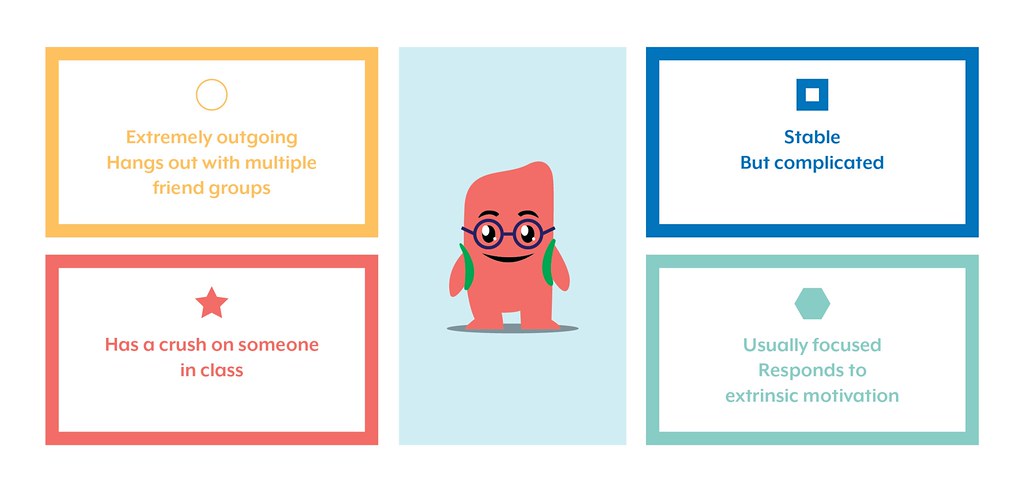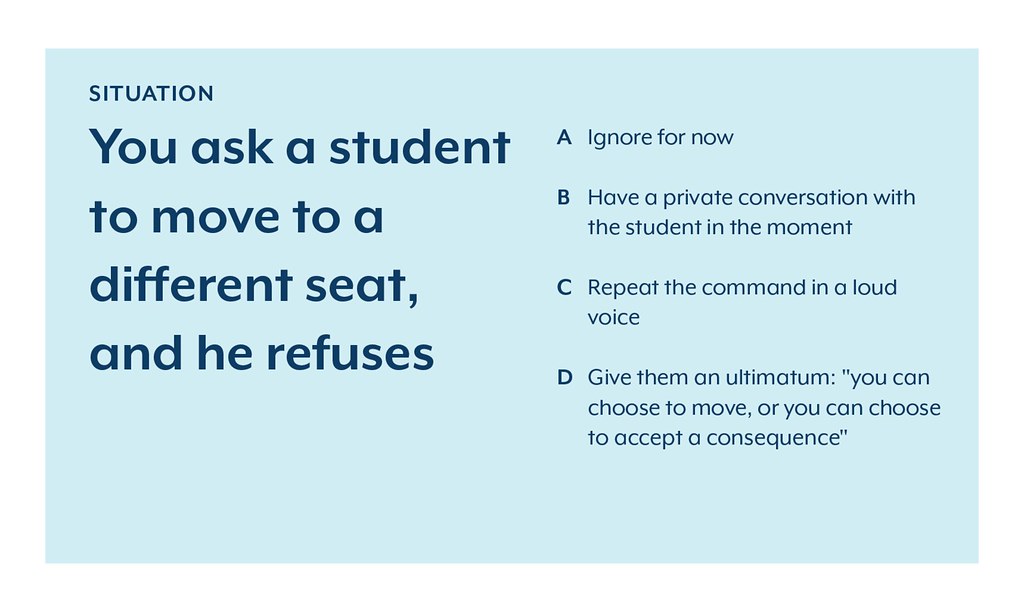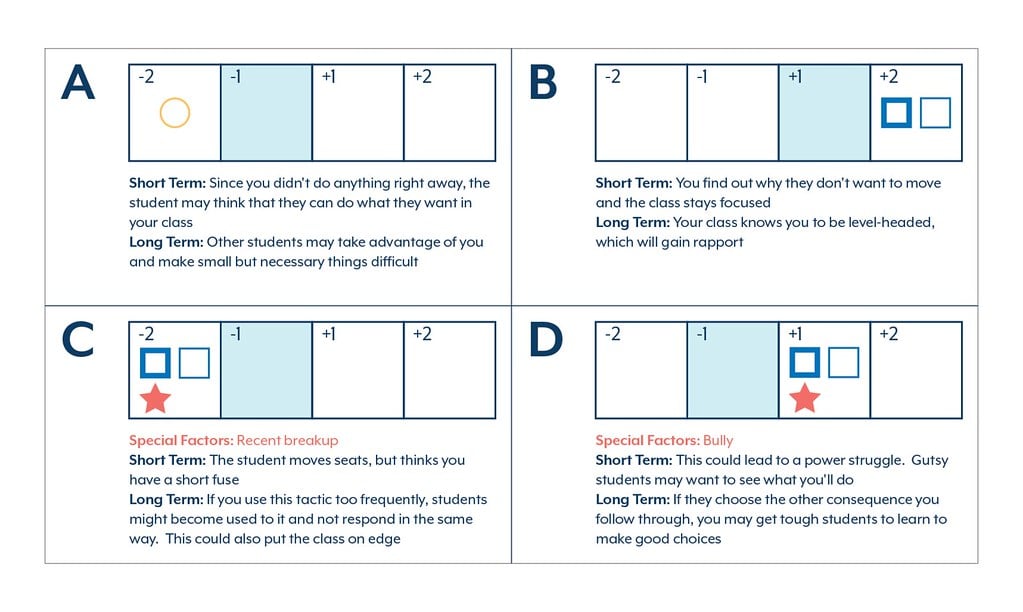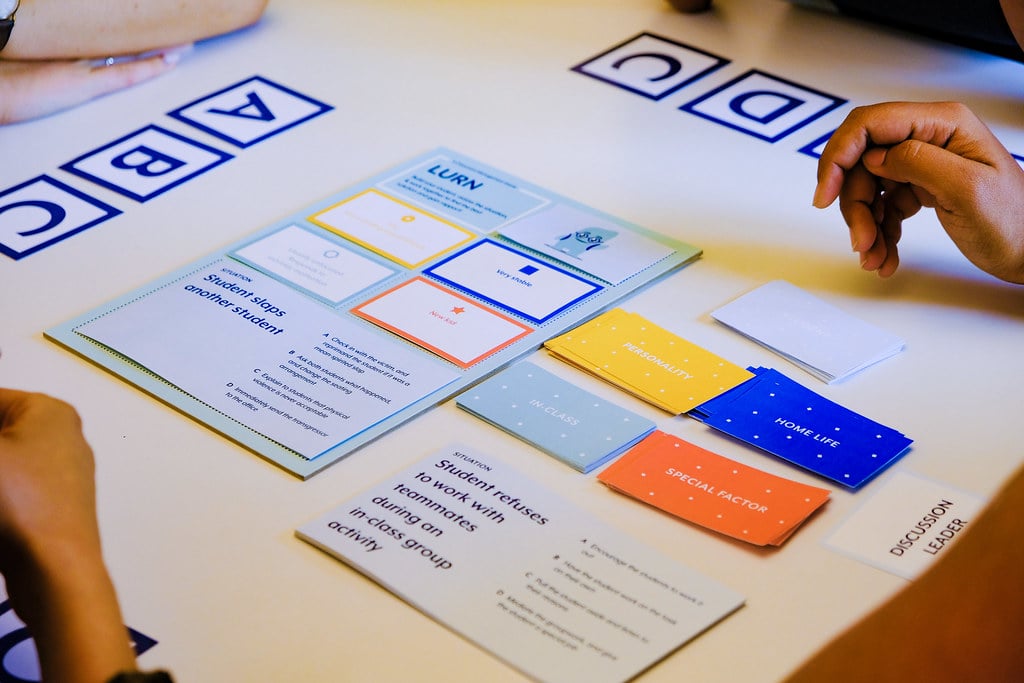A new way to learn classroom management
Brief
Context
Team
Timeline
My Role
How might we...
...help new teachers learn critical classroom management skills in a safe environment?
The Challenge
Some things can only be learned through experience. One of those things is classroom management — a teacher’s ability to act as facilitator, disciplinarian, counselor and confidante at a moment’s notice. Classroom management is one of the most impactful factors in students’ ability to learn—it ensures that students stay actively engaged, minimizes disruption to other students, sets repeatable norms and establishes positive rapport between students and teachers.
Missteps in classroom management are nearly unavoidable for new teachers, but can impact students in ways that are difficult to reverse.
Or as veteran teacher Freida Griffin puts it: “If you don’t have classroom management you can’t teach.”
The teacher training issue
Classroom dynamics are extremely multifaceted and contextual, and classroom chemistry is hard to predict. Students might carry baggage from previous interactions, or be completely unaccustomed to one another.
Factors like these simply can’t easily be conveyed through advice outside of a realistic context.

The Outcome
LURN is a board game designed to simulate a classroom environment in a workshop setting, to allow pre-service teachers to slow down and discuss their reactions, thinking fast and slow, and make the best decisions for their students.






Why use a game to teach classroom management?
A third space—a practice space—is needed that combines the authenticity of the practicum classroom with the control and scaffolding of the GSE seminar room (or through books).
—MIT Teaching Systems Lab
Authenticity: LURN is heavily based on the real-world experiences of dozens of teachers, and has been curated and tested by teachers to ensure its relevance to players.
Control: Thanks to games existing in a semiotic domain—a self-contained world with no real-world consequences—variables that would otherwise be unpredictable, such as time, can be adjusted to allow players to give significant thought to the issues presented.
Scaffolding: Players may adjust the difficulty of the game by starting with more or fewer initial points, or replacing situations with more challenging ones. This allows pre-service teachers to tailor the game to the challenges they can expect in their placement schools.
…And, of course, when done correctly, games offer a more engaging learning experience.
How to play
Classroom management is a complex topic, where sometimes you have to weigh individual students’ needs, and other times where you have to resist and make objective decisions. Through the course of this game, players are faced with students and situations, and challenged to work with their peers to determine the best strategy for maintaining a positive rapport with your students.

1. Build a student
Student profiles are built by players revealing four trait cards, one each for personality, home life, in-class attitude, and a special factor, each of which have a measurable impact on their behavior at school. Once traits are revealed, a fifth card puts a face to the student, and players are encouraged to give them a name and discuss the implications of their traits.

2. Reveal the Situation
The student who was just built then has an incident at school that would impact their or other students’ ability to learn. Players discuss how the student’s traits may have impacted his behavior, and choose a strategy to deal with it.
Each player votes before the score is revealed.

3. Scoring
Players’ responses are scored based on how that individual student might respond to the action taken.
An action deemed to be ideal is sometimes based on the student involved, but sometimes based on what is best for the class long-term.
Points earned represent classroom rapport, which, when earned or lost, affects the stability of the classroom over time.
Leveraging the EDGE Framework
The key to developing an educational game that balances education and fun is by ensuring that the learning objectives of the game, its design, and established learning principles all complement one another. To do this, we evaluated it using the EDGE framework developed by CMU researchers.

Mechanics, Dynamics and Aesthetics
The primary purpose of LURN is to elicit discussions among peers and mentors to prime learners for the factors they’ll have to consider when making in-the-moment decisions, and so our mechanics, dynamics and aesthetics center around giving metaphors in gameplay to the pressures a teacher will face, and our learning principles focus on self-guidance and discussion.
The most interesting dynamic that results is with the student building step, which prompts learners to consider the whole person, but steer away from superficial features in forming opinions of students.
Learning Principles
This game fosters learning by providing feedback, utilizing relatable situations, and encouraging peer dialogue to encourage students to ask deep questions.
Learning Objectives
By playing this game, players will come away with better reactions to student incidents in a shorter time, and giving due consideration for both short- and long-viewed responses and the effects they elicit. Stated formally:
Short Term Responses: Teachers will be able to scale their reactions to student behaviors appropriately in a given context, taking into account the visibility, directness, and degree of sternness in their response (e.g. volume, language, body language).
Long Term Responses: Given a student incident, teachers will be able to identify and apply effective strategies for re-establishing broken routines/expectations, including considering the frequency with which a pre-standing issue is addressed.
Our Process

Exploratory Survey
Since we wanted to understand teachers’ experiences more fully we reached out to expert teachers and novice teachers alike through a survey. We gathered 17 unique responses. From what the novices said, our insight was that in general, novices have very short-sighted responses to classroom incidents. They focused more on dealing with an issue in the moment, rather than dealing with the root of the issue. They would do things like yell at the students to make them stop talking or send students to the office for minor incidents.
From this, we understood the breadth of scenarios teachers encounter in the classroom and the factors that influence them. There isn’t an established framework for classroom management, so we experimented to create our own classification systems. This was important to try to formalize so that it could be easily incorporated into a system for game mechanics.

Ideation and Prototyping
We developed light concepts for three different gameplays, and dozens of possible game mechanics that could accompany them.
Since classroom management is very broad, we considered several topics: creating rules in the classroom and dealing with specific issues (which is what we chose).
The presence of feedback in the game was heavily considered throughout the prototyping process. We decided to start without any feedback from the game because we thought that the players would learn from developing their own rationales. In the first round of playtesting, we discovered that the players didn’t like this.
Competitive vs. collaborative gameplay was considered. We thought a competitive game would be more engaging, but collaborative could lead to better learning. In the end, the game was designed so that players could choose to play either competitively or collaboratively, but due to time constraints we only playtested the collaborative version.

Playtesting
We conducted five playtesting sessions with different audiences. Early on, we tested the game with non-teachers to ensure that the rules and mechanics were clear, and later we focused on teachers-in-training, who could speak more to the effectiveness and realisticness of the student personae and incidents.
One of the playtesters who was an administrator remarked that the student-trait cards didn’t fit together. When this happened, another player made up a student who made the four traits fit together. We saw this as a good outcome because it might teach administrators that students are more diverse than she previously thought.
Early playtesters, despite not having been teachers, were very cognizant of answers that would embarrass students.

Evaluation of Learning
The primary basis of our content sourcing consists of anecdotes from current or retired teachers who have provided responses to our game. In the initial research phase, we asked teachers what classroom management tactics they have changed since being beginners, and we based our situations around those.
Current teachers who have played our game have told us that it would be of particular use to newly admitted education students. However, because of the timing of our testing, none were available. Nonetheless, the pre-service teachers we tested with generated useful discussion when playing.

Visual Direction
Representation of Students
As we refined the design of the game, we went back-and-forth about how best to depict students. Ultimately, we decided on a non-human aesthetic, in part in order to establish a stronger fantasy element to the game, but more so to discourage stereotyping. Students are depicted in a lightly diverse manner.
Color Palette
Out of consideration our audience, we chose a color palette that would resonate with adults in a workshop setting.

Legacy
Serious Play Awards Gold Medal Winner
The LURN team was honored to receive a gold medal at the 2019 International Serious Play Conference.
Future Publishing
If you or anyone you know is interested in obtaining a copy of LURN, please don’t hesitate to reach out.



